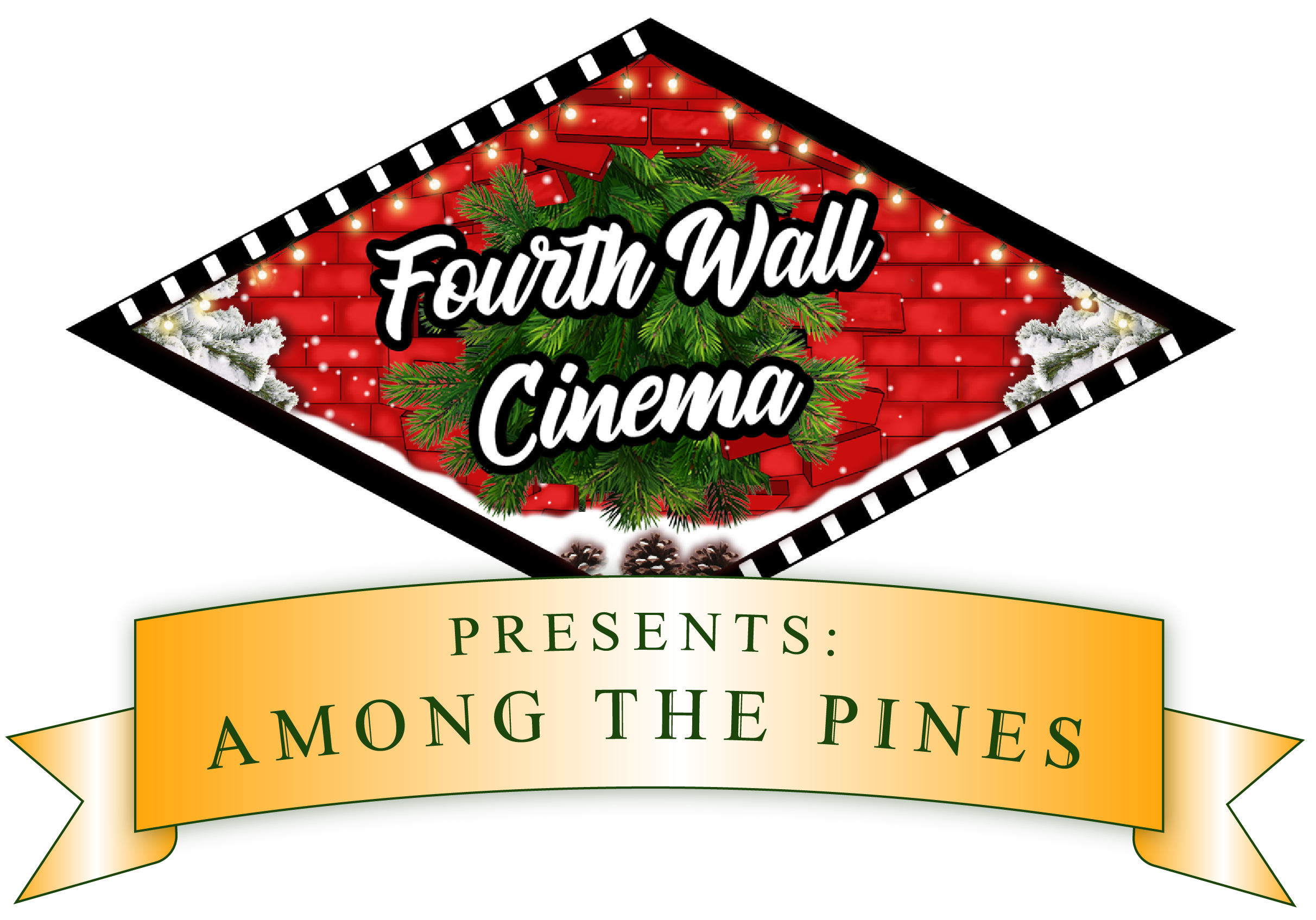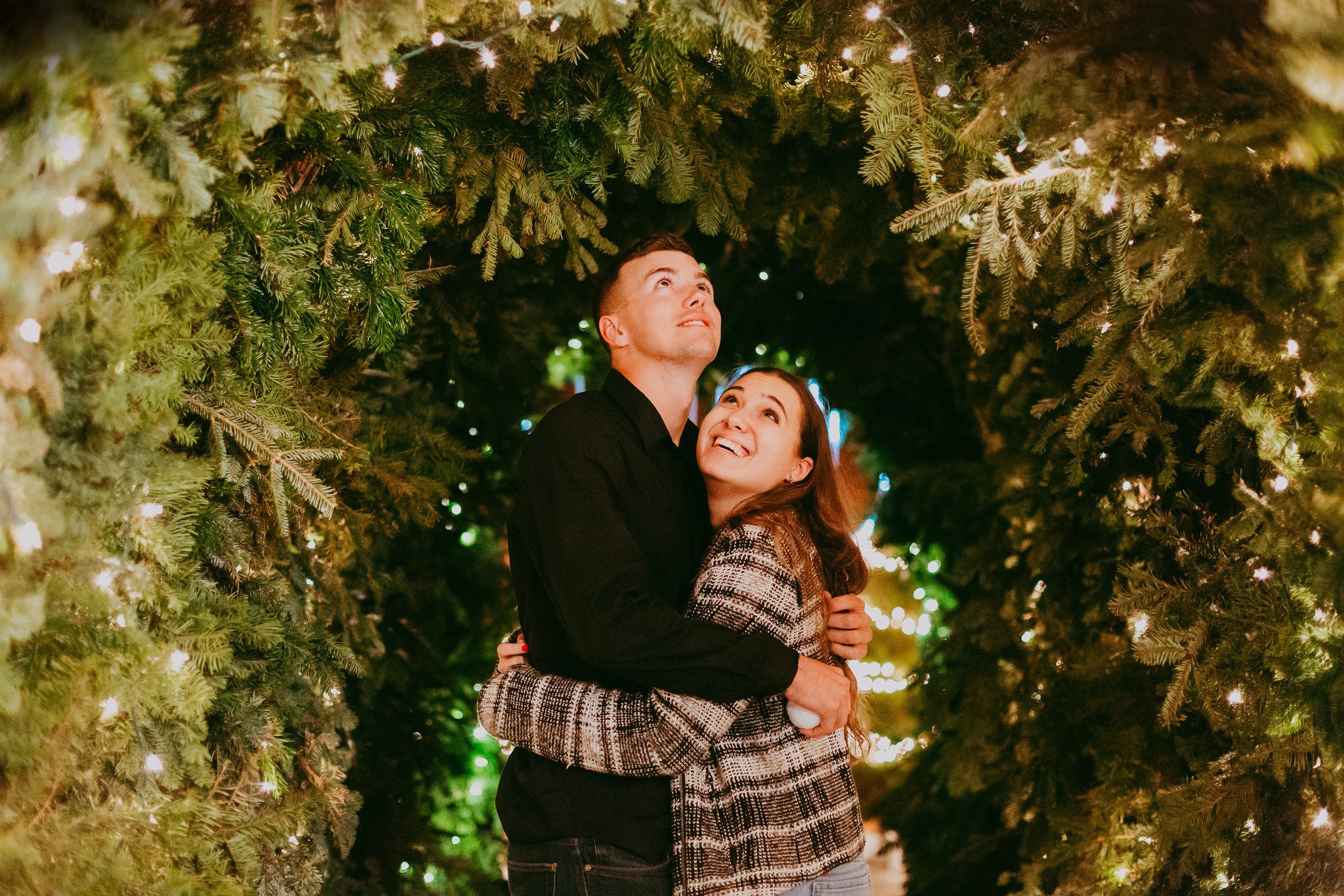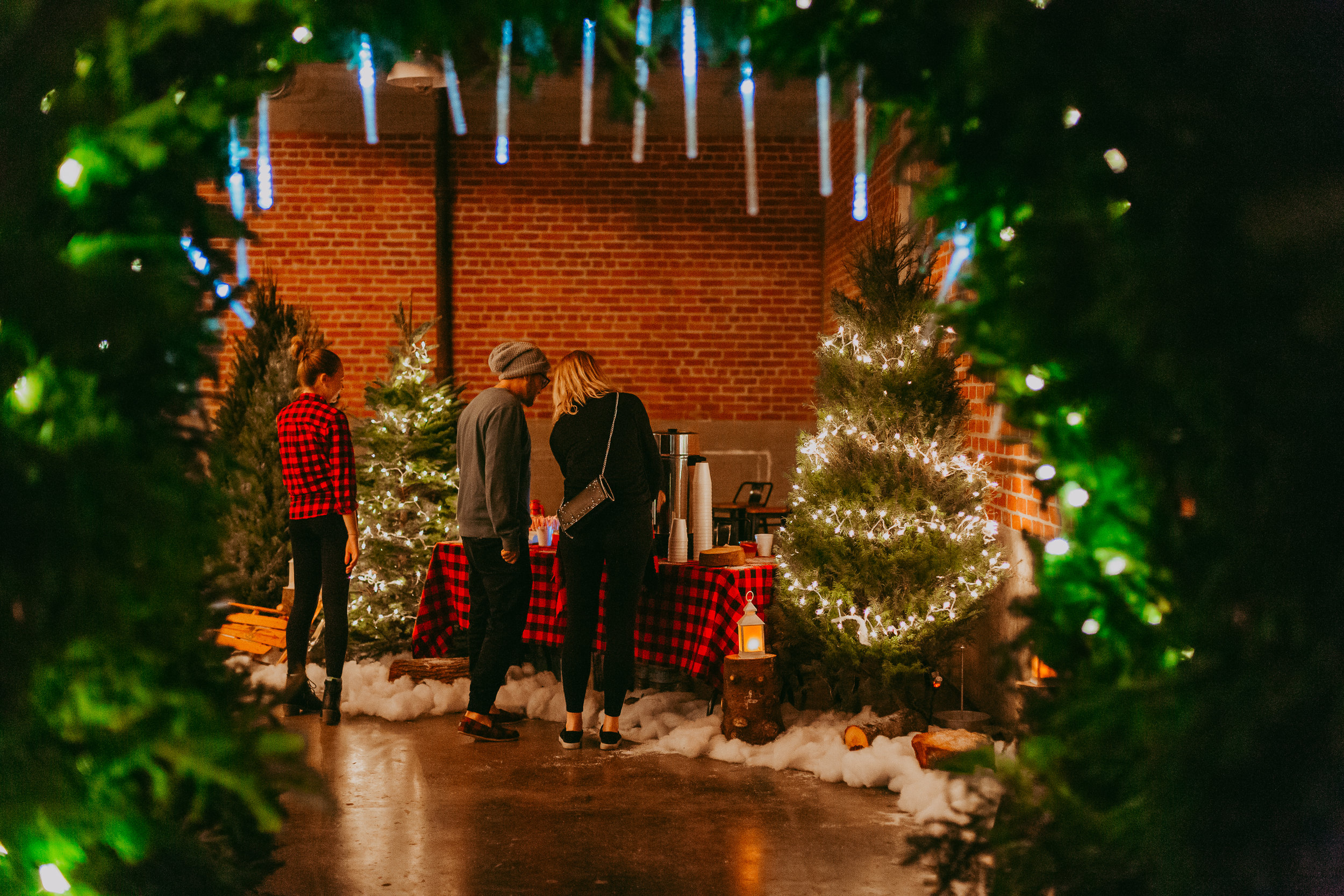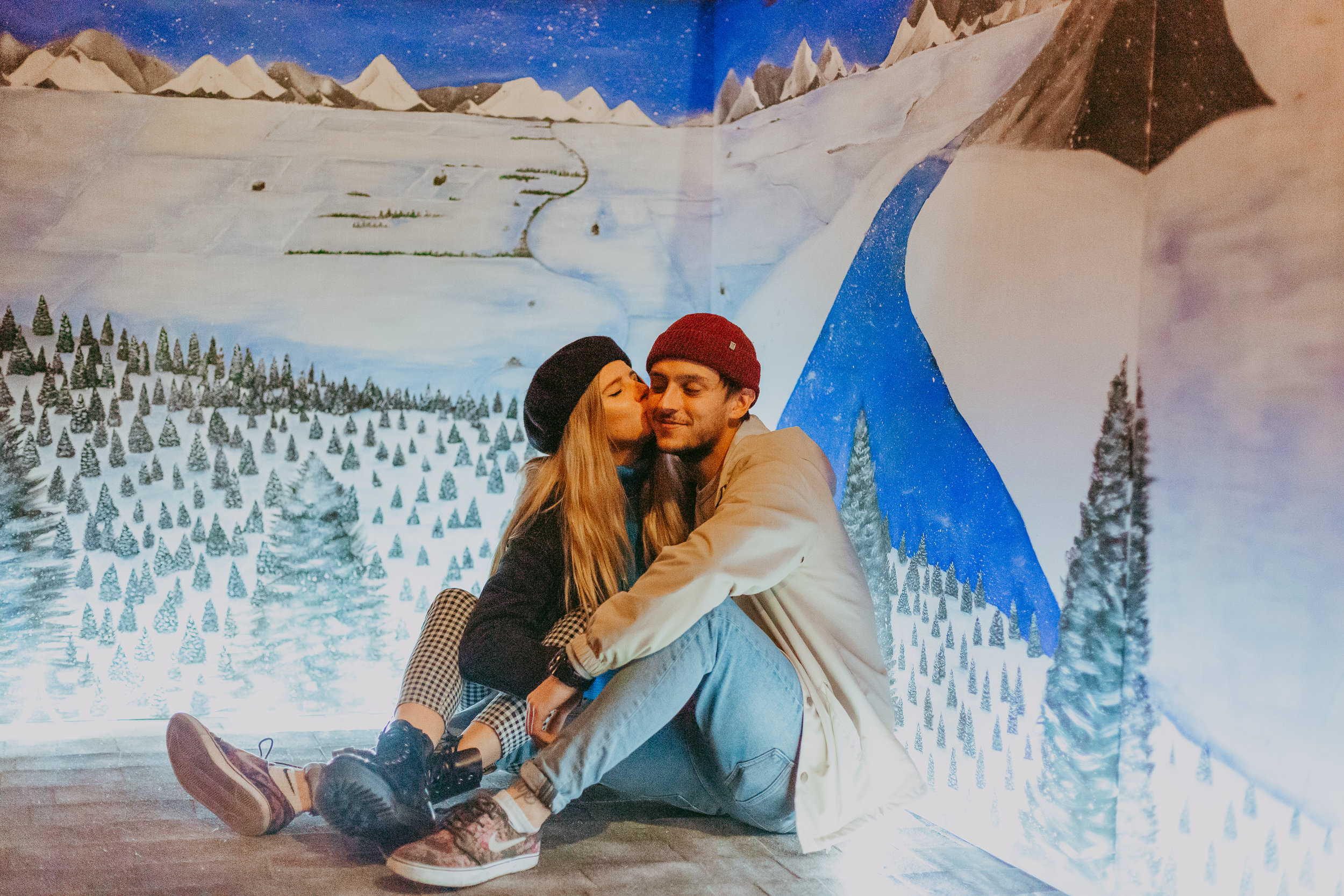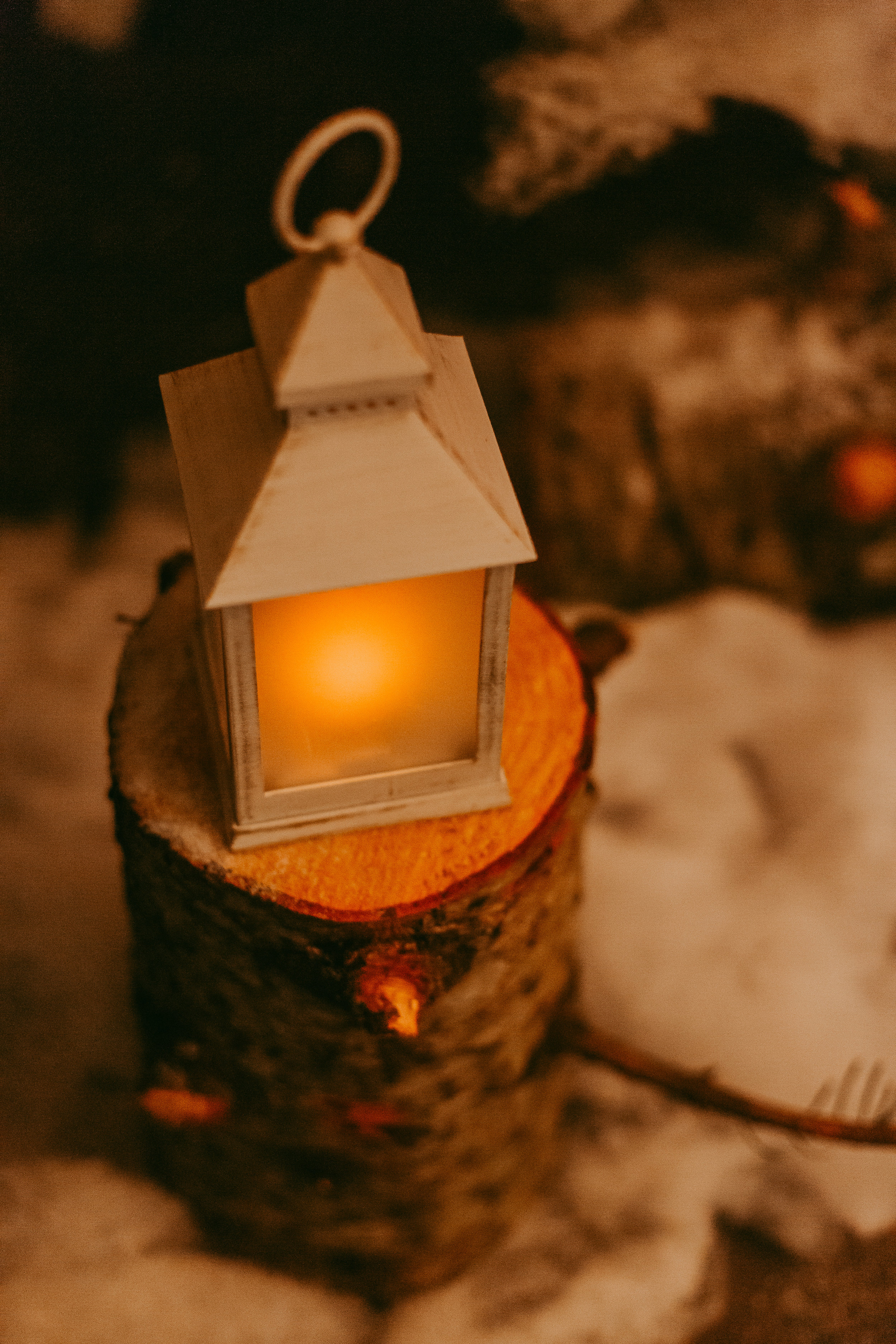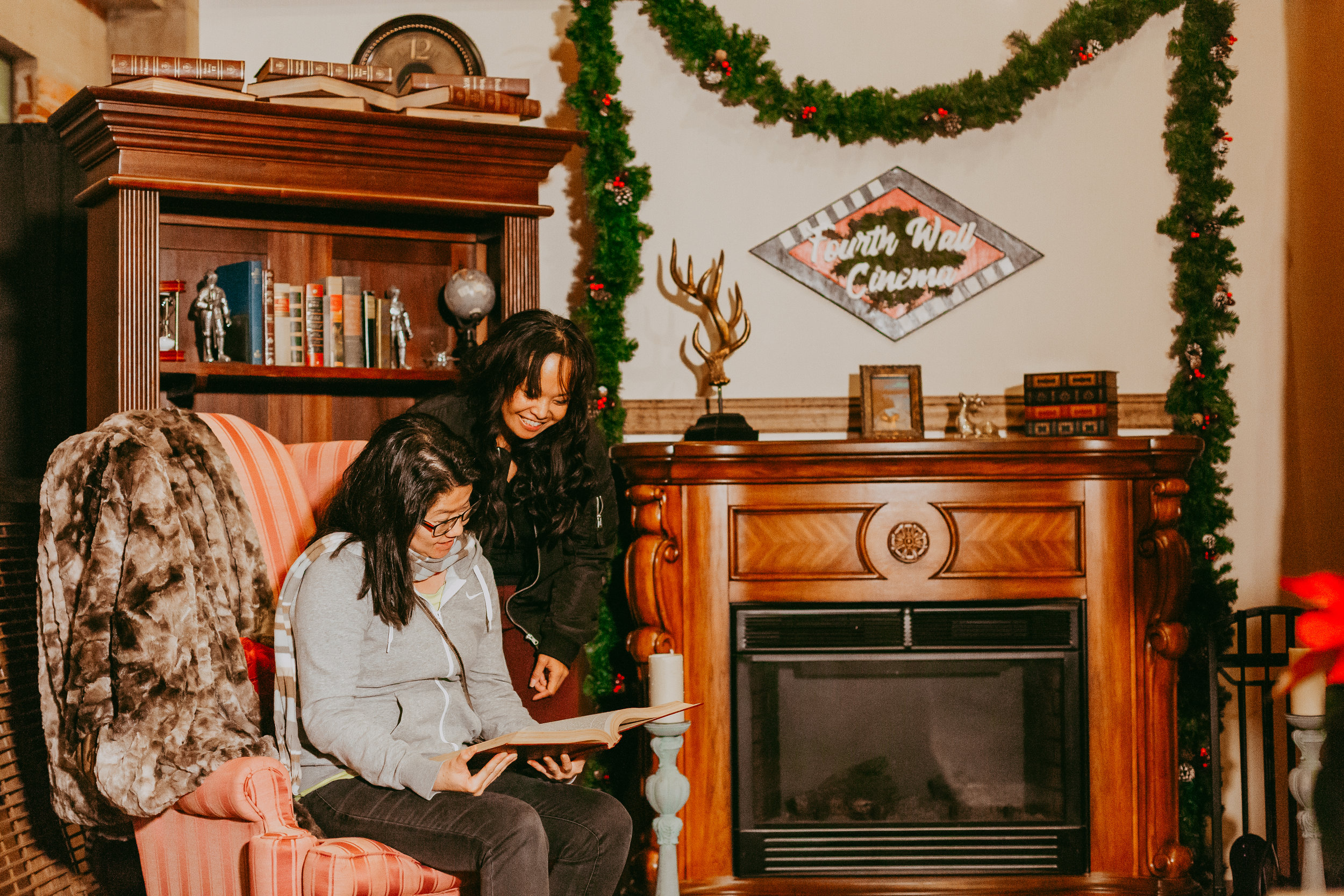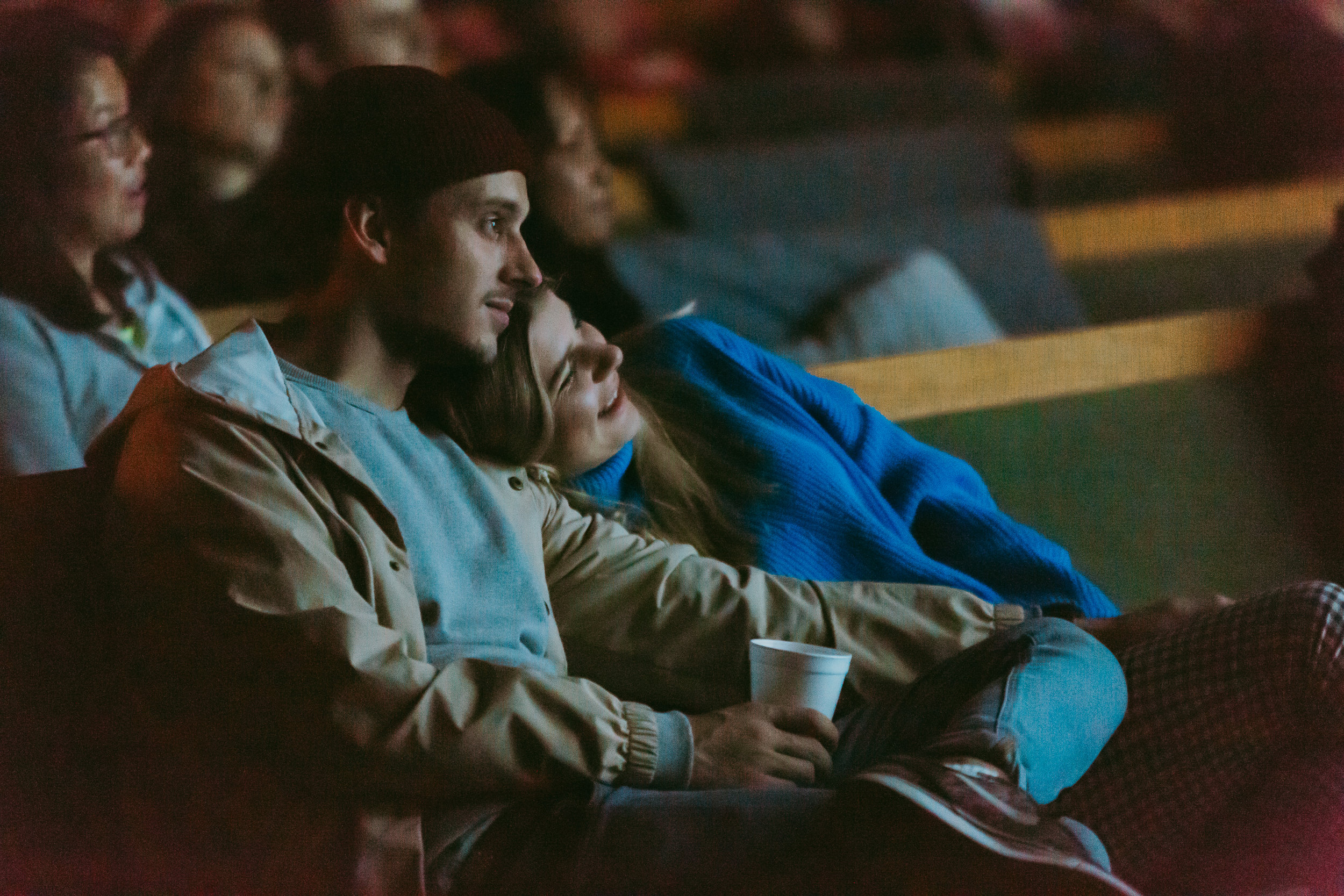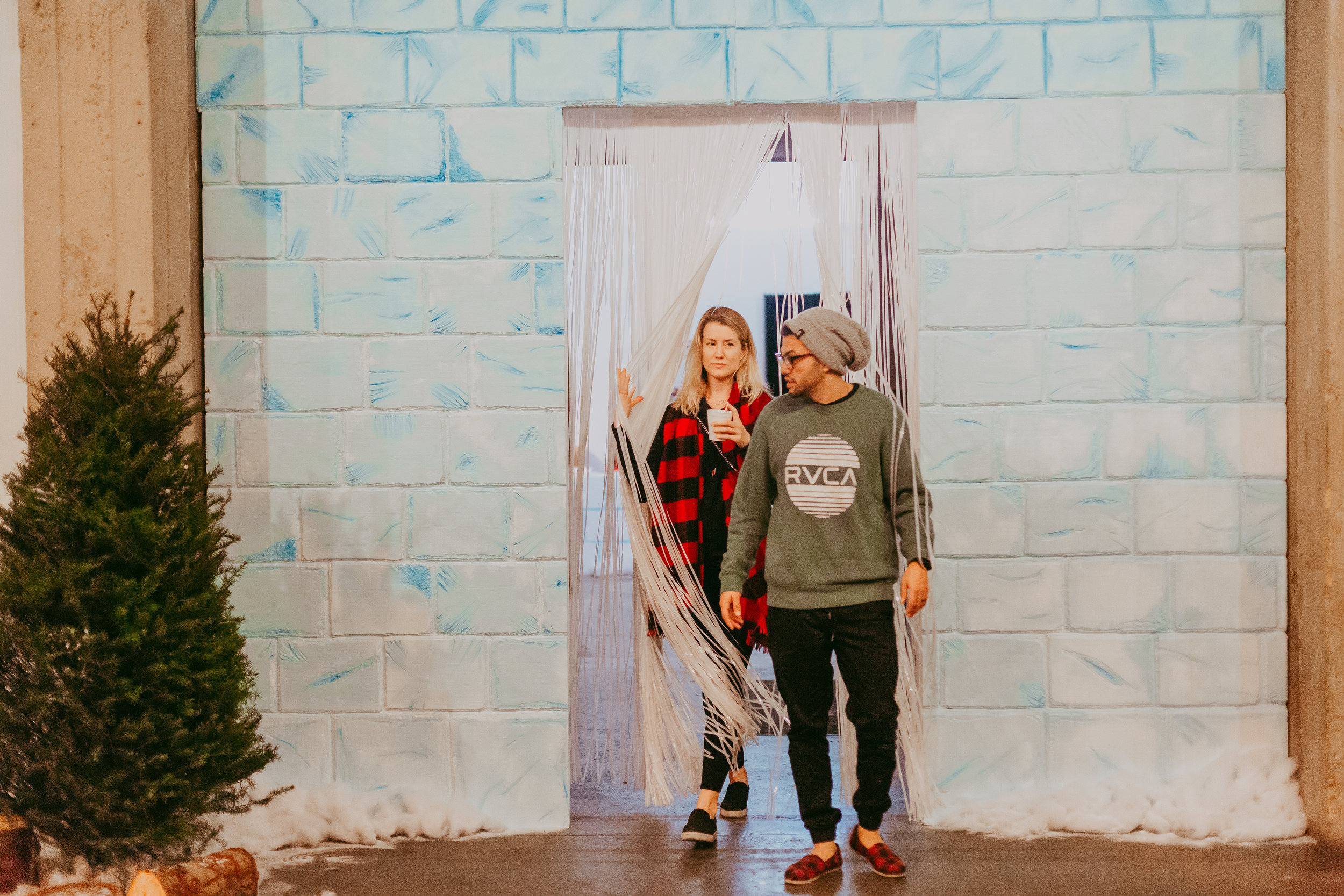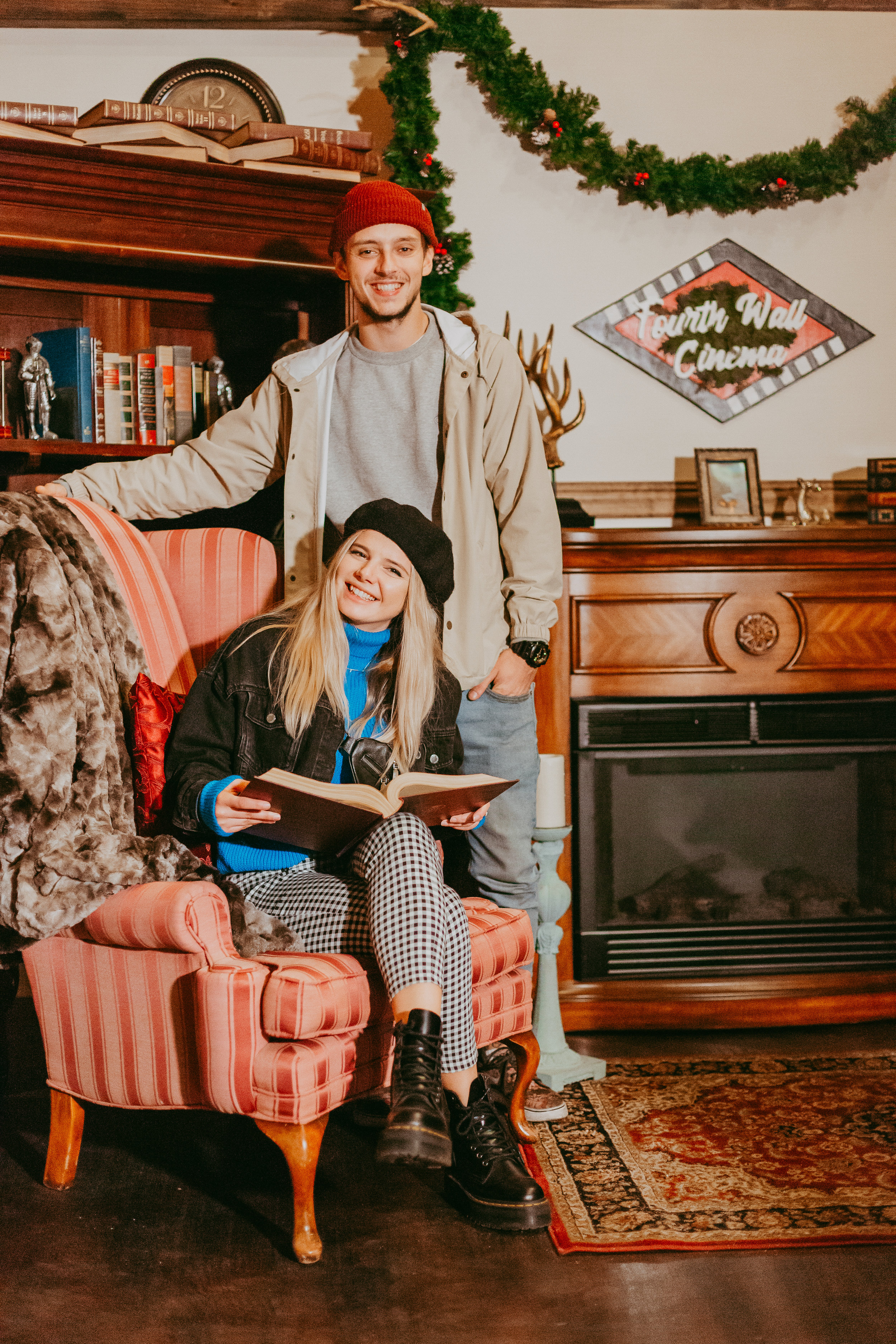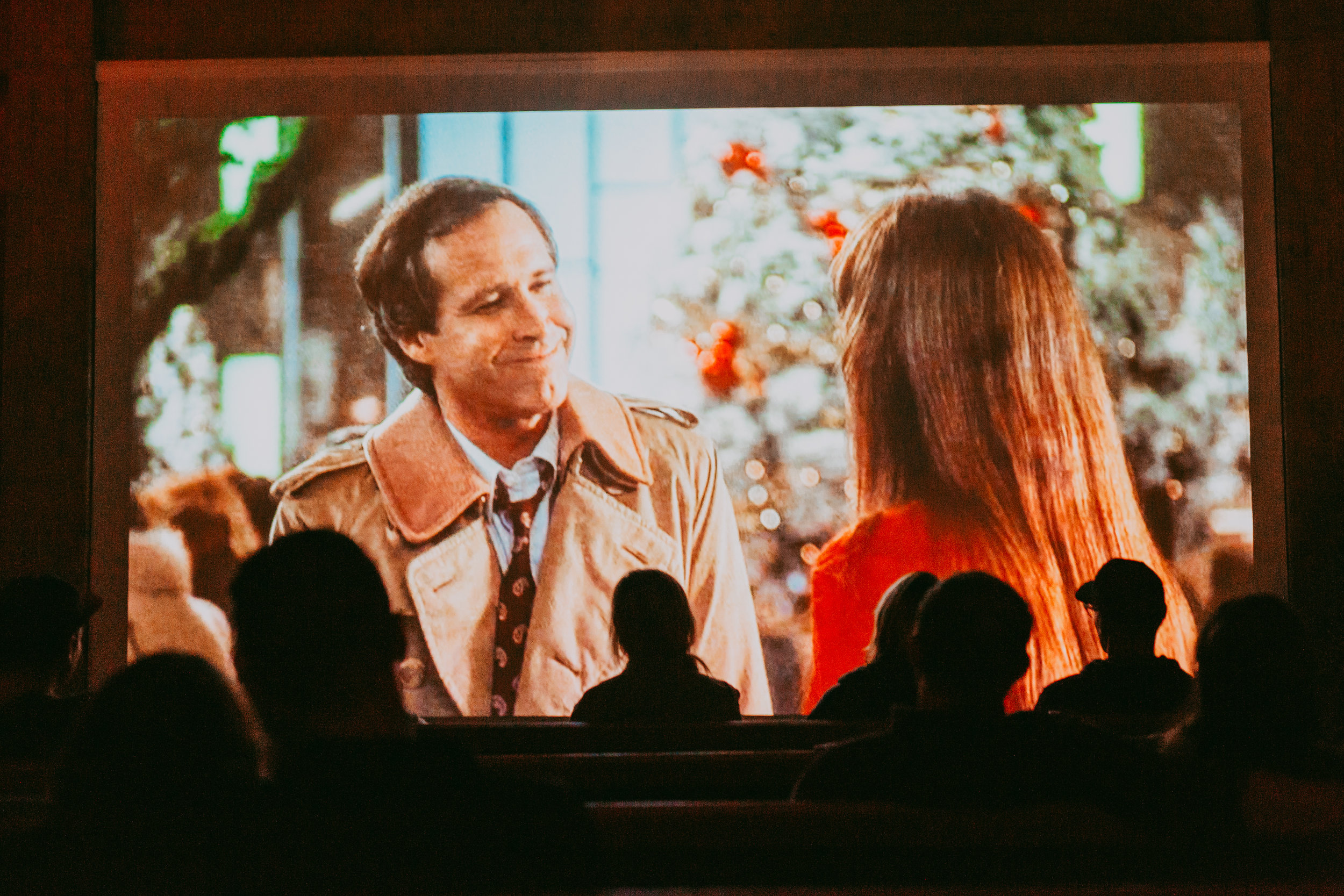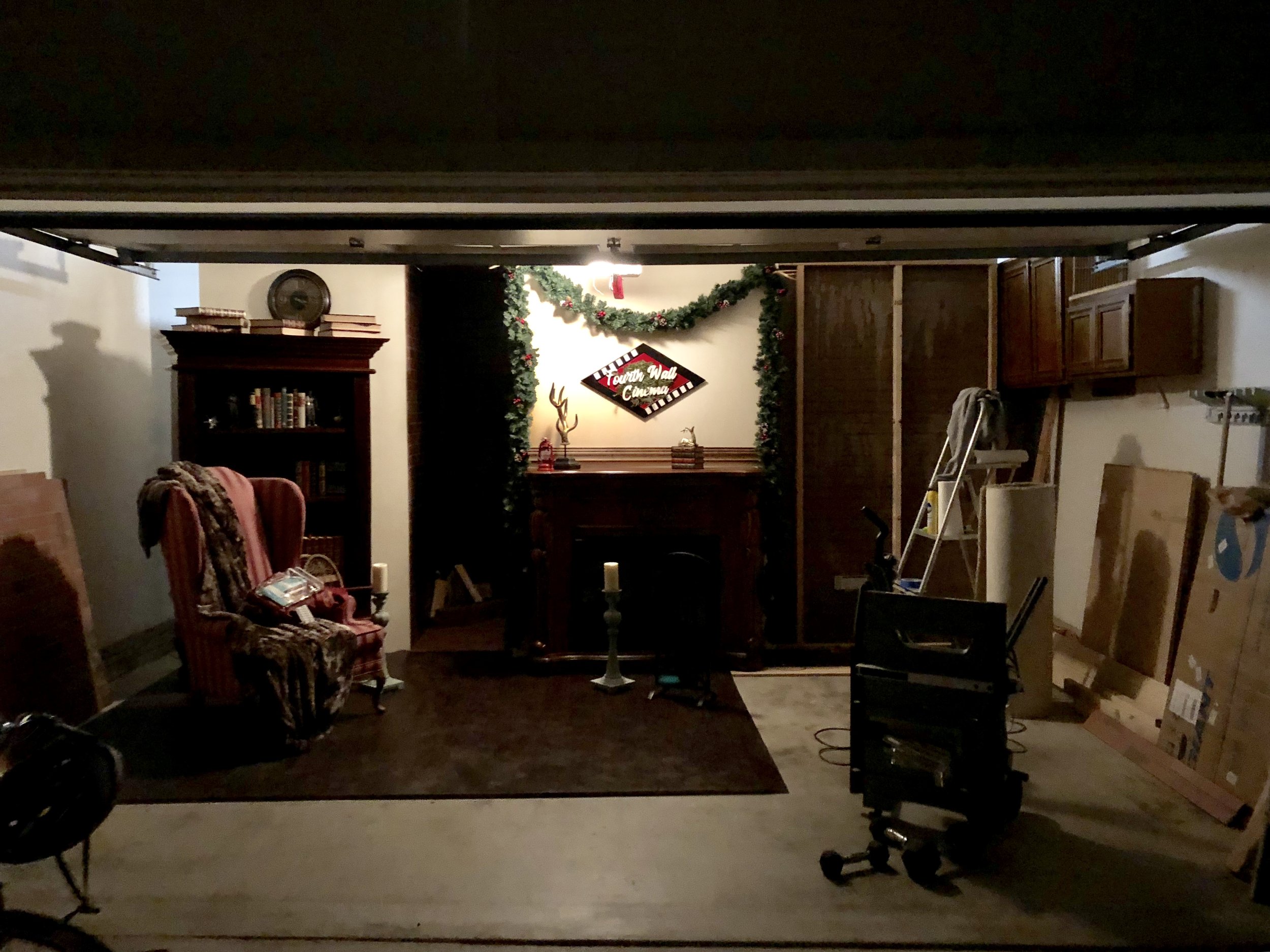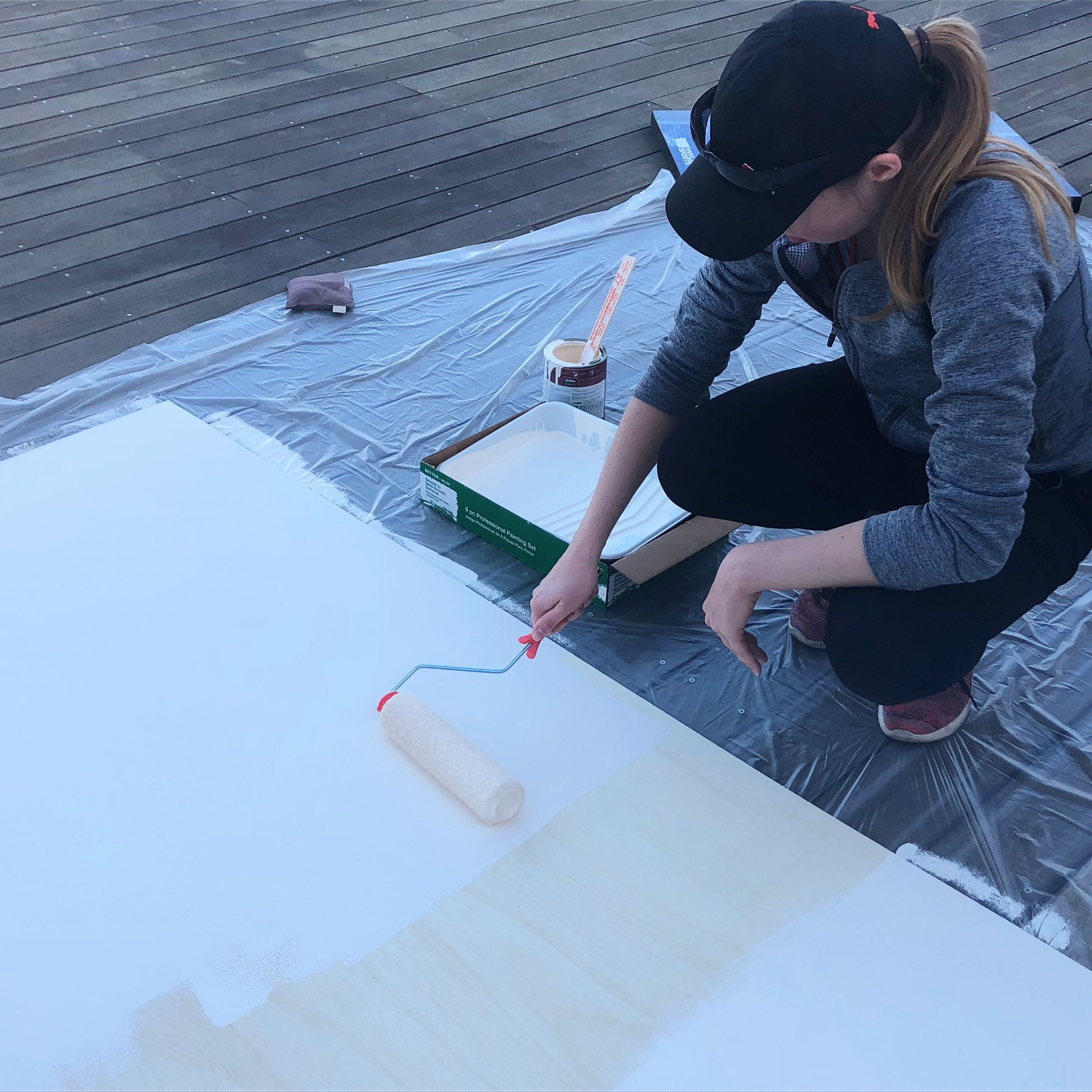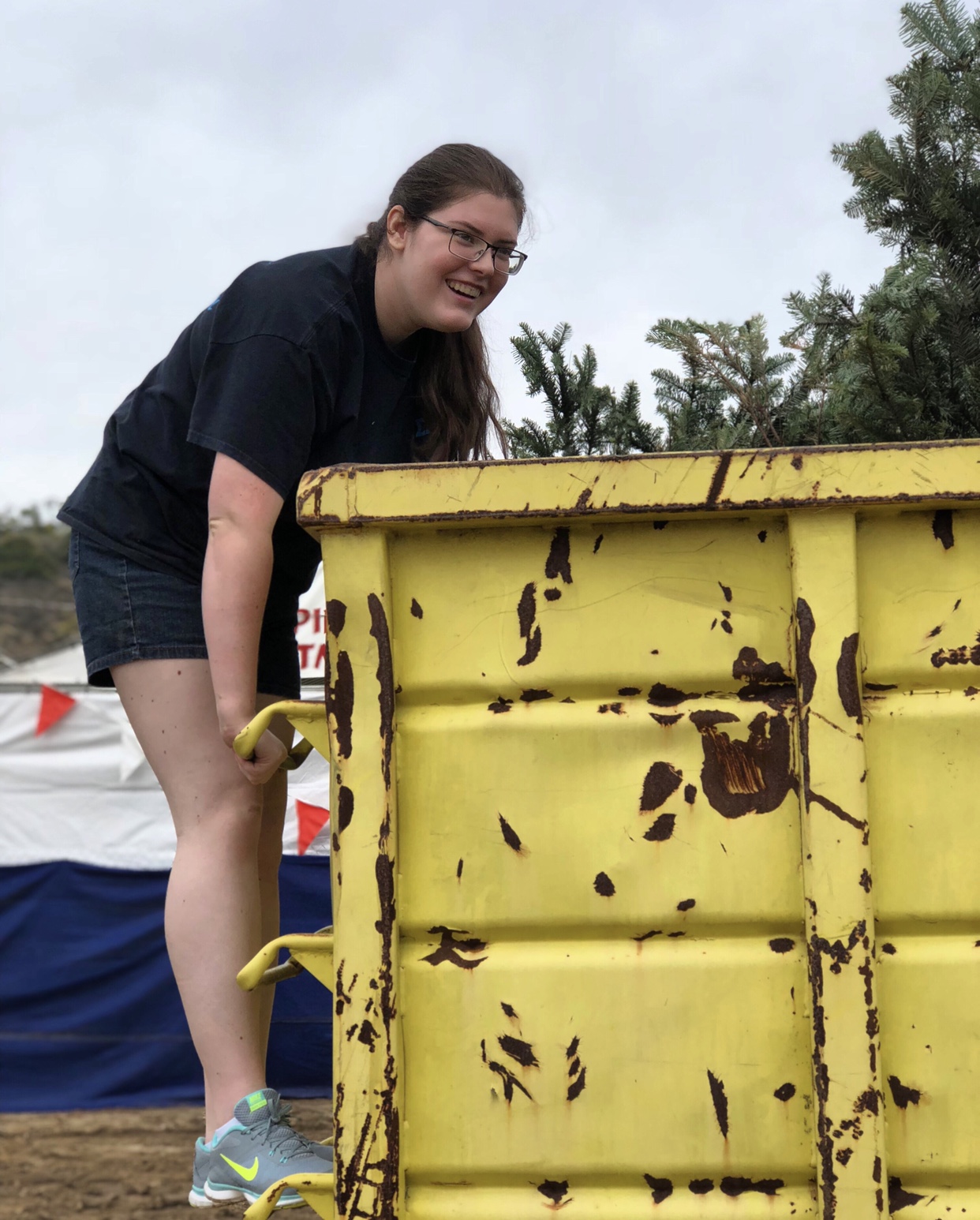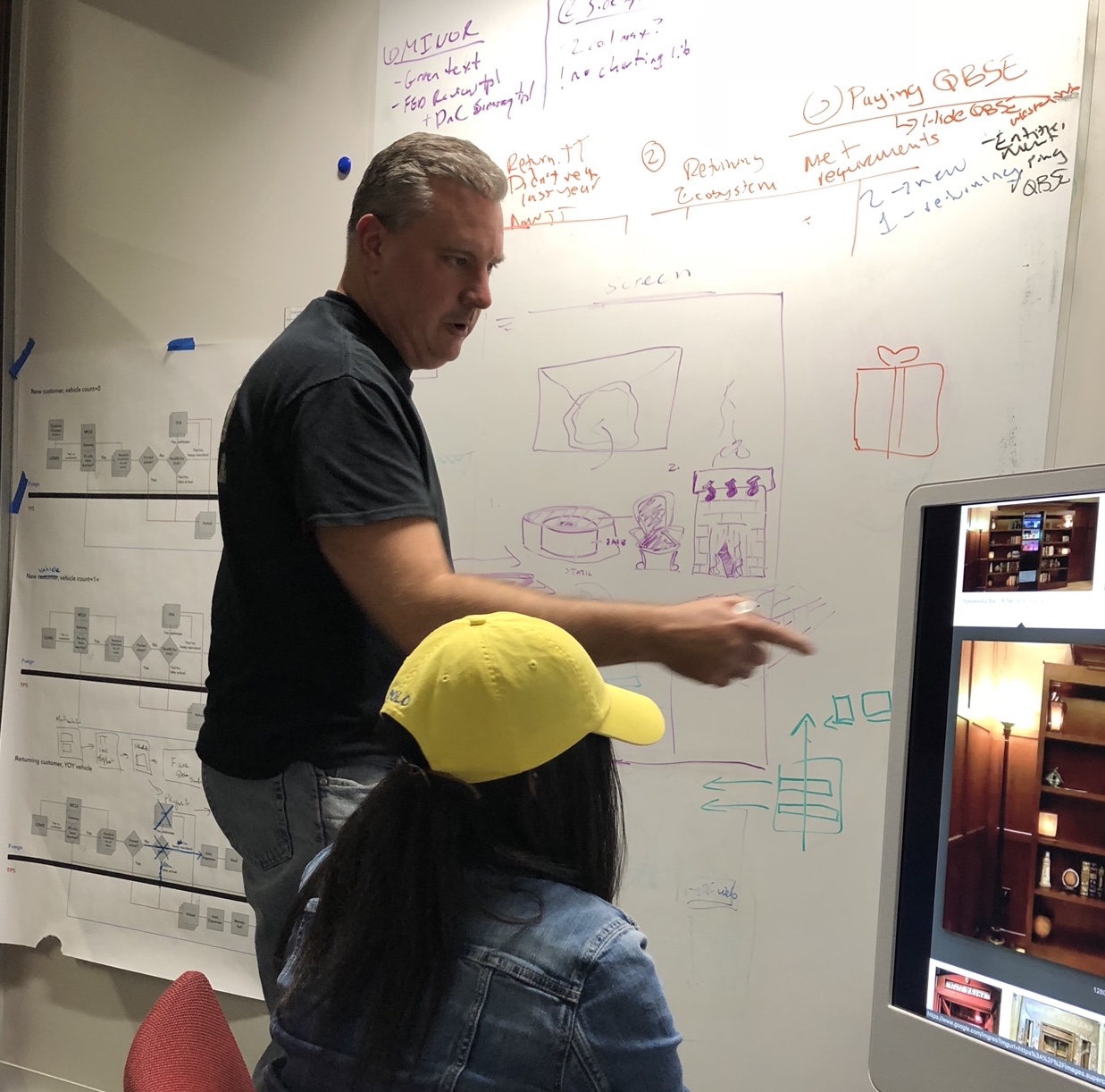I stumbled upon Backyard Cinema, a themed movie theater in the U.K., back in 2017 on a friend’s Instagram story. I’ve always been obsessed with experiences and naturally thought this was the coolest thing ever. I shared the below Facebook status and vowed to visit the London cinema someday. Little did I know, a team of three and I would create an immersive themed movie theater of our own almost two years later.
In early October 2018, we started Fourth Wall Cinema, which tears down the barrier between the audience and movie, so the two worlds collide. Both the handpicked movies and transformed physical theater space ladder up to a rotating theme. The movies are nostalgic, but secondary to the magical set design that visitors journey through to find their seats inside the theater. The experience interacts with all five of visitors’ senses.
We set very ambitious first event dates of December 14 & 15, 2018 with a theme in stark contrast to sunny San Diego: Among the Pines. The goal of our winter-themed first event was to drive awareness of the FWC brand and build marketing material for future pop-up events.
We rented a beautiful industrial 6,500 square-foot venue in downtown San Diego and worked with third-party movie licensing companies to lockdown films for each showtime:
Fast-forward to the weekend of the event–over 220 people attended. During the first showtime, I walked a mother and her young daughter from the parking lot to the venue’s entrance. She mentioned that she had taken her daughter out of school to surprise her with this. There were lots of moments like this: a daughter buying her mother tickets as a birthday present, couples using the occasion as a precious date night, and families splurging on four tickets for Christmas. Complete strangers enamored by the concept and seeing enough value in it to spend money. These moments were heart-melting and terrifying at the same time. We worked so hard to grab their attention and sell the tickets, but now we had to deliver. I prayed that the experience matched or better yet, surpassed their expectations.
I held my breath when these guests entered the venue. After photo-ops in front of the staged sitting area, we slid open the fireplace and the reactions on kids’ faces were priceless: pure disbelief. Even the adults were blown away and instantly started recording the entire experience. After the show, people asked when the next event was, if we traveled from city-to-city, and who was behind the whole thing. It was the most fulfilling feeling I’ve ever experienced and made the long days and nights all worth it.
Fourth Wall Cinema’s Among the Pines was the most challenging thing I’ve ever done, but also the most rewarding. I learned more in three short months than I could ever imagine. Each day was unique; the morning could be spent dumpster diving for pine branches at a Christmas tree farm while the afternoon consisted of shooting a video teaser to advertise the next morning. I tried so many things for the first time and sometimes, learned the hard way. There’s so much to talk about, but I want to focus on my learnings around design and marketing since to me, those are the most interesting.
DESIGN
We wanted the audience to enjoy the movie “among the snow-covered pines,” and access the concession stand through an igloo. To get there, guests traveled through a hidden fireplace entrance, down a chimney, across a rooftop, down a ladder, and through a lit and fragrant pine tunnel (complete with mistletoe), picking up their complimentary hot cocoa with marshmallows on the way out.
In reality, a completely blank canvas like a warehouse would’ve been best, but that had its own set of permit and zoning limitations. The venue we put a deposit on was gorgeous, but contained several nooks and crannies that were difficult to design for. We ended up designing things to fit awkward spaces, which was not ideal.
Along the way, we rebuilt certain pieces of the set design, so that they were more modular. Modularity became incredibly important for transport, as well as during set-up and tear-down on the days of the event. Since we had such a small team and short move-in/out times, pieces had to be as close to “customer-facing doneness” as possible and require no more than four people to assemble. We had to keep the venue door and U-Haul truck’s max height and width dimensions in mind while building.
Some of our assets, like the solid oak church pews we used for event seating, were incredibly heavy to move. To make transport from the storage unit to the venue easier, the pews were cut in half and custom dollies were built.
Speaking of attention to detail, we were given a floorplan by the venue that was missing many measurements. We also later realized that the dimensions it did include, were rounded.
Measure every wall, note every electric outlet and light fixture because you will need this information later on. We needed the exact measurements to build the set walls and curtain piping. We needed the outlet locations to figure out how to hide the wiring and connect the experience to one central switch that could be powered down during the movie. We needed the existing light locations to determine if they should be on or off, and how each affected the lighting design of the set.
For the set design concepts themselves, we started brainstorming and sharing mood boards pretty early on. We didn’t have concept sketches until much later, which looking back, should have been one of the first things we created. We would discuss the concept and even start figuring out the materials needed, halfway through realizing that each team member pictured a slightly different execution.
Failing to pull the concept out of one’s mind and visually represent the vision leaves it open to x different interpretations (x being the number of team members). It sounds like common sense, but we were trying to move so fast that sometimes the concepts would only be verbalized instead of drawn, which ended up costing us vast amounts of time and confusion later on.
My friend taught me an important lesson when we were ideating what the experience should be. The set design itself does not have to be literal. The concept can be communicated with various sensory cues, which convey the idea the designer is trying to deliver. For example, the chimney was horizontal (guests were not climbing vertically up it), yet people knew it was still a chimney because of the soot and burning embers running over the bricks. The fact that the experience transitioned from a fireplace entrance into the chimney also tied together the entire story.
MARKETING
Overview
Brands are constantly vying for consumers’ attentions and with so many stimuli, people have become desensitized to many forms of advertising. Even though I wholeheartedly believed we had something unique that people would care about, I knew that capturing their gaze long enough to accurately communicate the event concept would be challenging. We didn’t have a portfolio of previous events or many photos of our current event since we couldn’t fully set up the experience until the day before; there just wasn’t enough space in the garage to do so. We also didn’t want to give too much of the experience away beforehand since part of the fun was in the element of surprise.
We commissioned a gorgeous illustration to give people a taste. Prospective customers, however, still wanted actual photos of the experience, which was totally understandable. We received comments like this one:
Once we finished building the entrance to the experience in our garage, we filmed a teaser to give prospective customers something more tangible. People saw the video on the left, while the zoomed out version is the photo on the right:
On that note, I originally started with flufflier storybook-like content on the website that began with, “Trek through a snow-blanketed forest, uncover secret passageways, and discover a movie experience like no other. Feel the winter magic in the air as you cozy up to enjoy a classic holiday movie with family and friends.”
It was a little too mysterious. Some adventurous folks bought tickets purely because they were intrigued and wanted to find out what it was first-hand. Others asked for more clarification and when they understood, screamed, “What?! That’s awesome!” The higher the price, the less willing people are to take a chance. I was used to listing value propositions when marketing a product and quickly learned that value props were just as important when marketing an experience:
What didn’t work
Some mediums we used to market really worked while others fell flat. Before I get into what succeeded, here were some of the hard learned lessons:
Before tickets were available for purchase (we were still ironing out some of the legal stuff and price breakdown with the third-party movie licensing companies), we launched a splash page to collect emails and Facebook event pages to start building a following.
During that time, I started running Facebook ads with the goal of getting people to click the “Interested” button on our event pages. I thought that once our tickets became available (and could even be purchased on Facebook with an Eventbrite integration), converting these people would be not easy, but hey, they had expressed “interest” and were leads.
I was so very wrong–an “Interested” click is at the tippy top of the conversion funnel. In hindsight, I’m personally guilty of clicking “Interested” on local events to keep them on my radar and share with friends, while I only go to maybe 2% of them. A quick inventory of other local events tells the same story: thousands are “Interested,” while a couple of hundred are “Going” on Facebook, and even that’s not an accurate count most times.
We took a chance with one of the more traditional forms of marketing: radio. I knew that social would be key, but this first event was also a learning experience and I had discovered music fests, haunted houses, and other upcoming events via radio in the past.
I thought there could potentially be less competing noise (no pun intended) on radio. I asked, “How many distractions were there for someone alone in their car?” In reality, probably more than is safe to acknowledge. I also recognized that getting someone to remember a call-to-action and actually follow-through from a radio ad was a much more difficult barrier to overcome than clicking on a digital CTA in the moment.
On radio, we were paying for an estimated number of impressions and frequency; companies advertising on the radio didn’t share their radio-driven sales numbers with them. All that radio account managers could speak to was that companies continued to pour more money into radio, which must mean they were seeing results.
We tiptoed and invested a small amount by radio standards, but a large amount for us, into a two-week radio placement on a radio station that our target audience listened to. We prioritized repetition over primetime, which left us with a graveyard shift. We were maybe five or six in a string of fifteen consecutive ads airing at 9pm and we all know by that point, we would’ve all changed the radio station! Not one sale was attributed to radio.
Another important learning was related to pricing. Most of our ticket sales came in the days leading up to the event, and even the days of. I learned that the possibility of the event selling out wasn’t a big enough incentive for people to purchase tickets early, at least not for a first-time event. People need some sort of push or they’ll wait until the last minute to buy.
It’s always hard to set the price for something completely new. We didn’t want to go too low and leave money on the table, but also didn’t want to go too high and have no ticket sales. Among the Pines was primarily a marketing event, but we still wanted to break-even.
We settled on $32 per ticket, which I do believe the experience was worth, especially compared to what people were paying for other events in San Diego and only getting a fraction of the value. As time went on, I realized we could only charge this price after establishing a name for ourselves and people saw what we were capable of creating. We needed to lower the price to get people through the door first though.
We did have a considerable amount of people pay the original price before we lowered it in an attempt to generate more demand (which it did), but you never want to see an email like this:
I replied and the customer was completely understanding; I think we actually made a loyal customer for life based on his response. At the same time, I knew other customers felt the same way, but just hadn’t emailed us about it.
What worked
Okay, now for some of the marketing tactics that really worked! Besides word-of-mouth from family and friends, Instagram was our most successful advertising channel because that’s where our target audience’s attention was and the platform’s tools allowed us to tap into it.
As mentioned above, most of our ticket sales came in the hours leading up to the event. It’s not over until the fat lady sings or the showtime passes. While guests were sitting for each movie, I used the two-hour block to sell more tickets. I ran Instagram ads within a few mile radius around the venue. A couple of showtimes later, people would enter the event saying, “My boyfriend and I were scrolling through Instagram looking for something to do on Friday night and we saw this! Figured we’d check it out.”
I’d also find the most recent photos posted to Instagram with “Downtown San Diego” tagged, figuring those people might still be close by and likely, tourists (many photos were of people posing with famous San Diego landmarks).
Speaking of DMing, there’s some amazing free marketing that can be done if you’re willing to put in the time (and we had more time than money with all of the other event expenses). I’d find hashtags for local interactive art installations, speakeasies, and other events that contained an element of what were were doing and then do my own version of Amazon’s “People like you also purchased…”. Many DMs were ignored, but every one out of ten people responded and that one person would bring three more to the event. Some even respected the hustle:
Local online publications and newspapers were also free and a big win for us. It was surprising how many “Everything You Need to Do in San Diego This Winter” lists there were and most of them just took email to get onto.
FINAL THOUGHTS
Whew–that was a lot! Writing this blogpost, and reliving the event in the process, reminded me of the infinite lessons learned along the way. Perhaps to an even greater extent, documenting a few of them reminded me of how much I still have to learn when it comes to creating experiences. I’m hungry to hone the crafts of experiential design and marketing. Cheers to all of the incredible experiences that have yet to be built!

